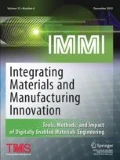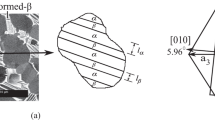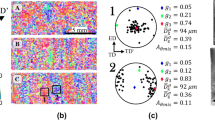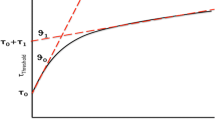Abstract
This paper investigates the role of material microstructures in structural analysis and establishes the need for microstructure-integrated constitutive models in predicting structural response. A focus is on microstructure and temperature dependency of stresses and plastic strains in a structural panel under realistic loading conditions. Structural analysis is conducted using the recently developed uncertainty-quantified parametrically homogenized constitutive model (UQ-PHCM) for near-alpha Titanium alloys like Ti6242S. PHCMs exhibit explicit microstructural dependency and are developed from homogenization of crystal plasticity finite element simulation results with machine learning. Uncertainties due to model reduction, data sparsity and microstructural variability are accounted for in the model. Structural response with the UQ-PHCMs is compared to those predicted by isotropic elasticity and \({J}_2\) plasticity models without explicit microstructure information. Parametric studies illustrate how different uncertainties in the UQ-PHCM framework propagate to the structural response variables. The results also show the relative contribution of different microstructural features to the propagated uncertainty in structural response variables. The studies establish the UQ-PHCM as an effective tool for reliable structural analysis with consequences in material design.












Similar content being viewed by others
References
Bagri A, Weber G, Stinville J, Lenthe W, Pollock T, Woodward C, Ghosh S (2018) Microstructure and property-based statistically equivalent representative volume elements for polycrystalline Ni-based superalloys containing annealing twins. Met Mater Trans A 49:5727–5744
Brouwer K, McNamara J (2020) Generalized treatment of surface deformation for high-speed computational fluid dynamic surrogates. AIAA J 58(1):329–340
Chaboche J (2008) A review of some plasticity and viscoplasticity constitutive theories. Int J Plast 24(10):1642–1693
Culler A, McNamara J (2011) Impact of fluid–thermal–structural coupling on response prediction of hypersonic skin panels. AIAA J 49(11):2393–2406
Dimitrios S, George S (2016) Assessment of the effect of microstructural uncertainty on the macroscopic properties of random composite materials. J Compos Mater 51:2707–2725
Duane S, Kennedy A, Pendleton B, Roweth D (1987) Hybrid Monte Carlo. Phys Lett B 195(2):216–222
Eason T, Spottswood S, Chona R, Penmetsa R (2013) A structures perspective on the challenges associated with analyzing a reusable hypersonic platform. In: 54th AIAA/ASME/ASCE/AHS/ASC structures, structural dynamics, and materials conference, vol 1. American Institute for Aeronautics and Astronautics (AIAA), pp 4624–4638
Ghanem R, Red-Horse J (2017) Polynomial chaos: modeling, estimation, and approximation. Springer, Berlin, pp 521–551
Gockel B (2016) Constitutive response of a near-alpha titanium alloy as a function of temperature and strain rate. Ph.D. thesis, Carnegie Mellon University
Gockel B, Kolesar R, Rollett A (2016) Experimental study of an aerospace titanium alloy under various thermal and tensile loading rate conditions. Integr Mater Manuf Innov 5(1):13
Groeber M, Jackson M (2014) DREAM.3D: a digital representation environment for the analysis of microstructure in 3D. Integr Mater Manuf Innov 3(1):5
Groeber M, Ghosh S, Uchic M, Dimiduk D (2008a) A framework for automated analysis and simulation of 3D polycrystalline micro structures. Part 1: statistical characterization. Acta Mater 56:1257–1273
Groeber M, Ghosh S, Uchic M, Dimiduk D (2008b) A framework for automated analysis and simulation of 3D polycrystalline micro structures. Part 2: synthetic structure generation. Acta Mater 56:1274–1287
Hoffman M, Gelman A (2014) The No-U-Turn sampler: adaptively setting path lengths in Hamiltonian Monte Carlo. J Mach Learn Res 15(1):1593–1623
Hombal V, Mahadevan S (2011) Bian minimization in Gaussian process surrogate modeling for uncertainty quantification. Int J Uncertain Quantif 1(4):321–349
Honarmandi P, Arróyave R (2020) Uncertainty quantification and propagation in computational materials science and simulation-assisted materials design. Integr Mater Manuf Innov 9:103–143
Hu X, Chen X, Parks GT, Yao W (2016) Review of improved Monte Carlo methods in uncertainty-based design optimization for aerospace vehicles. Prog Aerosp Sci 86:20–27
Isserlis L (1918) On a formula for the product-moment coefficient of any order of a normal frequency distribution in any number of variables. Biometrika 12(1–2):134–139
Karafillis A, Boyce M (1993) A general anisotropic yield criterion using bounds and a transformation weighting tensor. J Mech Phys Solids 41(12):1859–1886
Kotha S, Ozturk D, Ghosh S (2019a) Parametrically homogenized constitutive models (PHCMS) from micromechanical crystal plasticity FE simulations, part I: sensitivity analysis and parameter identification for titanium alloys. Int J Plast 120:296–319
Kotha S, Ozturk D, Ghosh S (2019b) Parametrically homogenized constitutive models (PHCMS) from micromechanical crystal plasticity FE simulations: part II: thermo-elasto-plastic model with experimental validation for titanium alloys. Int J Plast 120:320–339
Kotha S, Ozturk D, Ghosh S (2020) Uncertainty-quantified parametrically homogenized constitutive models (UQ-PHCMs) for dual-phase alpha/beta titanium alloys. NPJ Comput Mater 6(117):1–20
Kouchmeshky B, Zabaras N (2010) Microstructure model reduction and uncertainty quantification in multiscale deformation processes. Comput Mater Sci 48(2):213–227
LaFontaine J, Gogulapati A, McNamara J (2016) Effects of strain hardening on response of skin panels in hypersonic flow. AIAA J 54(6):1974–1986
Loève M (1977) Probability theory I, vol 45. Springer, New York
Ma X, Zabaras N (2010) An adaptive high-dimensional stochastic model representation technique for the solution of stochastic partial differential equations. J Comput Phys 229(10):3884–3915
Matheron G (1963) Principles of geostatistics. Econ Geol 58(8):1246–1266
Ozturk D, Kotha S, Pilchak A, Ghosh S (2019a) Parametrically homogenized constitutive models (PHCMS) for multi-scale predictions of fatigue crack nucleation in titanium alloys. JOM: J Miner Met Mater Soc 71(8):2657–2670
Ozturk D, Kotha S, Pilchak A, Ghosh S (2019b) Two-way multi-scaling for predicting fatigue crack nucleation in titanium alloys using parametrically homogenized constitutive models. J Mech Phys Solids 128:181–207
Ozturk D, Kotha S, Ghosh S (2020) An uncertainty quantification framework for multiscale parametrically homogenized constitutive models (PHCMS) of polycrystalline Ti alloys. J Mech Phy Solids 2020 (in review)
Pinz M, Weber G, Lenthe W, Uchic M, Pollock T, Ghosh S (2018) Microstructure and property based statistically equivalent RVES for intragranular gamma–gamma’ subgrain microstructures of Ni-based superalloys. Acta Mater 157:245–258
Plunkett B, Lebensohn R, Cazacu O, Barlat F (2006) Anisotropic yield function of hexagonal materials taking into account texture development and anisotropic hardening. Acta Mater 54(16):4159–4169
Quiroz R, Embler J, Jacobs R, Tzong G, Liguore S (2012) Predictive capability for hypersonic structural response and life prediction: phase II—detailed design of hypersonic cruise vehicle hot-structure. Technical report AFRL RQ-WP-TR-2012-0265, Wright-Patterson AFB, OH
Ricciardi CO, Niezgoda S (2019) Uncertainty quantification for parameter estimation and response prediction. Integr Mater Manuf Innov 8:273–293
Ricciardi D, Chkrebtii O, Niezgoda S (2020) Uncertainty quantification accounting for model discrepancy within a random effects Bayesian framework. Integr Mater Manuf Innov 9:181–198
Salloum M, Templeton J (2014) Inference and uncertainty propagation of atomistically informed continuum constitutive laws, part 2: generalized continuum models based on gaussian process. Int J Uncertain Quantif 4(2):171–184
Saltelli A, Ratto M, Andres T, Cariboni J, Gatelli D, Saisana M, Tarantola S (2008) Global sensitivity analysis: the primer. Wiley, Hoboken
Schmidt M, Lipson H (2009) Eureqa. www.nutonian.com. Accessed Apr 2017
SIMULIA DS (2014) ABAQUS
Thapa M, Mulani S, Walters R (2019) Stochastic multi-scale modeling of carbon fiber reinforced composites with polynomial chaos. Compos Struct 213:82–97
Tu X, Shahba A, Shen J, Ghosh S (2019) Microstructure and property based statistically equivalent RVEs for polycrystalline-polyphase aluminum alloys. Int J Plast 115:268–292
Venkatramani G, Ghosh S, Mills M (2007) A size-dependent crystal plasticity finite-element model for creep and load shedding in polycrystalline titanium alloys. Acta Mater 55(11):3971–3986
Voce E (1955) A practical strain-hardening function. Metallurgica 51:219–226
Wang Y, McDowell D (2020) Uncertainty quantification in materials modeling. In: Wang Y, McDowell D (eds) Uncertainty quantification in multiscale materials modeling. Elsevier series in mechanics of advanced materials. Woodhead Publishing, Sawston, pp 1–40
Acknowledgements
This work has been supported through a subcontract to JHU (sub-recipient) from The Ohio State University (main recipient) through a sub-award No. 60038238 from an AFRL Grant No. FA8650-13-2-2347 as a part of the AFRL Collaborative Center of Structural Sciences. The program managers of this grant are Dr. Benjamin Smarslok and Dr. R. Chona, and the PI is Prof. J. McNamara. This support to JHU is gratefully acknowledged. Computing support from Hopkins High Performance Computing Center (HHPC) and Maryland Advanced Research Computing Center (MARCC) is gratefully acknowledged. The authors would like to thank Prof. J. McNamara and Dr. Kirk Brouwer from The Ohio State University for providing the panel configuration for analysis.
Author information
Authors and Affiliations
Corresponding author
Ethics declarations
Conflict of interest
On behalf of all authors, the corresponding author states that there is no conflict of interest.
Rights and permissions
About this article
Cite this article
Kotha, S., Ozturk, D., Smarslok, B. et al. Uncertainty Quantified Parametrically Homogenized Constitutive Models for Microstructure-Integrated Structural Simulations. Integr Mater Manuf Innov 9, 322–338 (2020). https://doi.org/10.1007/s40192-020-00187-z
Received:
Accepted:
Published:
Issue Date:
DOI: https://doi.org/10.1007/s40192-020-00187-z




